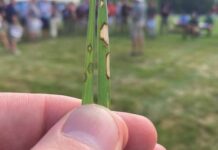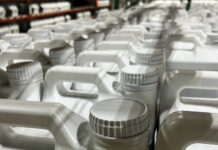Reduced weed competition from summer annuals such as crabgrass, cooler temperatures and shorter day length that results in less time for soil drying all facilitate turf establishment. In many cases, home lawns don’t need complete reestablishment, but only reseeding of small areas or interseeding into a thin lawn to increase density. The following are five tips from Michigan State University Extension for fall seeding success.
1. Is seeding necessary?
The first question to answer is if seeding is even necessary. If the turf is thin or there are small patches of dead grass about the size of baseballs, a fertilizer application and cool temperatures should help the existing turfgrass to recover and spread into the bare spots. If the bare areas are the size of soccer balls or larger, or if the area only has sporadic green patches of turf, then interseeding is necessary to restore the area to turf.
Another consideration is to assess weed pressure. If the turf is covered in crabgrass, it’s going to be difficult to have new seedlings compete with crabgrass. If weed competition is severe, make sure to kill the weeds before seeding.
2. Seed-to-soil contact
A successful seeding starts with good seed-to-soil contact. Broadcasting seed onto an area without incorporating the seed into holes, slits or coverings with soil will feed birds, but not be effective for growing new turfgrass. Equipment such as core aerifiers, power rakes, slit seeders or even hand-raking small areas will get the job done.
For established areas that may just need an interseeding to improve density, core aerification is a viable option. It’ll also give you the benefit of improving soil aeration that is critical for many sites that have compacted soils or high clay content soils. The best method for incorporating seed is to use a slit seeder. Slit seeders create a slice in the soil that the seed falls directly into and ensures good seed-to-soil contact. To improve establishment and turf spread, slit seed in at least two directions perpendicular to each other. Many lawn care companies offer this service or if you’re a do-it-yourselfer, core aerators and slit seeders might be available at a local rental store.
Click here to read the rest of the tips.











![[VIDEO] Dickies®: Discover Workwear That’s Anything But Uniform](https://turfmagazine.com/wp-content/uploads/2023/06/1647663814-4b1a2a7742790a9b1e97a3b963477850192e1d6a9dfba9b07214a77bae25d6e3-d-218x150.jpg)






























![[VIDEO] Dickies®: Discover Workwear That’s Anything But Uniform](https://turfmagazine.com/wp-content/uploads/2023/06/1647663814-4b1a2a7742790a9b1e97a3b963477850192e1d6a9dfba9b07214a77bae25d6e3-d-324x160.jpg)